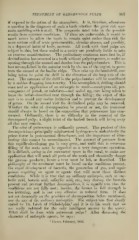Page 897 - My FlipBook
P. 897
TREATMENT OF GANGRENOUS PULPS. 907
if exposed to the action of the atmosphere. It is, therefore, oftentimes
a question in the diagnosis of such a tooth whether the great risk war-
rants meddling with it at all. The prognosis must take in the })ossible
results from systemic conditions. If these are unfavorable, it would be
much better to allow the tooth to remain quiet rather than risk the
more serious evil of acute pericementitis, alveolar abscess, and possibly,
in a depraved habit of body, necrosis. All teeth with dead pulps are
subject to this, but those sealed in a cavity are peculiarly liable to take
on extreme manifestations. The preliminary treatment must first be, if
devitalization has occurred in a tooth without pulp-exposure, to make an
opening through the enamel and dentine into the pulp-chamber. This is
best accomplished in the anterior teeth by the use of the engine, to pene-
trate the enamel at the basilar ridge. Then take up the hand-drill, care
being taken to point the drill in the direction of the long axis of the
root. The entrance of the drill in the pulp-chamber will be manifested
by a sudden dropping into a cavity. This accomplished, drilling should
cease and an application of an antiseptic be made—eucalyptus oil, per-
manganate of potash, or iodoform—and sealed up, care being taken to
leave the before-described vent through the filling ; the object of this
care is to avoid any undue irritation and to prevent the development
of germs. On the second visit the devitalized pulp may be removed.
Whether the odor of decomposition be present or not, the treatment
should always be based on the supposition that putrescence has com-
menced. Ordinarily, there is no difficulty in the removal of the
decomposed pulp : a slight twist of the barbed broach will bring away
all that may remain.
The odor of putrescence is ordinarily present. The product of this
—
decomposition ])rincipally sulphuretted hydrogen—is undoubtedly the
prime factor in pericemental disturbance, and the importance of elim-
inating this cannot be overestimated. The amount of pressure from
this rapidly-developing gas is very great, and until this is overcome
filling of the roots must be regarded as a very dangerous operation.
It is difficult, owing to the contracted space in the canal, to make any
application that will reach all ])arts of the tooth and chemically change
the gaseous products ; hence a vent must be left, as described. The
philosophy of the treatment must be based on the conditions present,
the rapid development of bacteria, the generation of gas, and septic
poison requiring an agent or agents that will meet these distinct
conditions. While it is true that an ordinary antiseptic, such as car-
bolic acid, boracic acid, salicylic acid, etc., may destroy the bacteria
present and prevent further decomposition, it is equally true that the
conditions are not fully met; besides, the former in full strength is
too irritating, and is not very effective in reduced form. It does
not act chemically on the products of decomposition before mentioned,
nor do any of the ordinary antiseptics. The subject was first clearly
stated by Dr. Litch of Philadel])hia,^ and it is to his M'ork that we
are really indebted for the only intelligent answer to the query,
What shall be done with putrescent pulps? After discussing the
character of antiseptic agents, he says :
^ Cof-mos, February, 1882.


